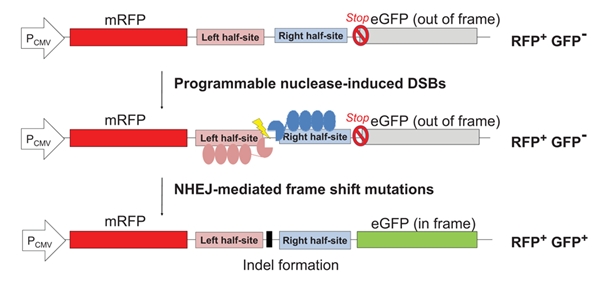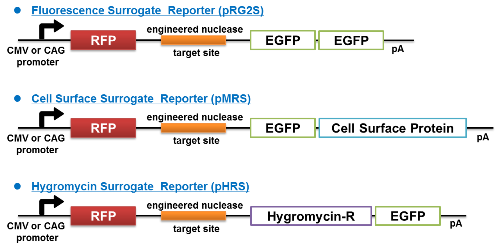Surrogate reporter system
| Supplier |
|---|
| ToolGen-LabOmics |
| Product |
| Surrogate Reporter backbone vectors |
Features
- ZFNs,TALENs & CRISPR (RGEN) validation: Fast and easy validation of engineered nucleases (ZFNs, TALENs & CRISPRs) in a cell-based reporter assay
- Genome edited clones enrichment: Enrichment of cells whose genomes have been modified by engineered nucleases (ZFNs,TALENs, CRISPRs)
They crawl to the warmth of human bodies led by hunger and thirst: that’s tthe answer to how do bed bugs get in your bed. But before getting in your bed they live somewhere around your house. Learn more to check all the possible places!
The surrogate reporters are composed of genes encoding two fluorescent proteins (red and green) linked by the Engineered Nuclease (EN) target sequence. In the absence of ENs expression, the reporters are designed to express the red but not the green fluorescent protein. Upon expression of ENs, which can digest the target site within the surrogate reporter DNA, ultimately leading to frameshift mutations, the green fluorescent protein gene is functionally restored and thus both fluorescent proteins are expressed. The restoration of green fluorescent protein expression is strictly dependent on the presence of ENs (or other types of engineered nucleases that specifically recognize the target sequence in the reporter construct). Additionally, the fraction of cells that displays the green fluorescence signal correlates very well with the efficiency of the EN.
Furthermore, in two of the reporter systems, a third reporter gene is linked to the EGFP gene, allowing additional forms of selection. In one case, the expression of a cell-surface protein allows selection by magnetic-activated cell sorting; in the other case, expression of an antibiotics-resistance gene allows selection by transient exposure to antibiotics (Hygromycin). These two selection methods are gentler and and more accessible than FACS.

Fig. 1. Surrogate reporter structure
Furthermore, in two of the reporter systems, a third reporter gene is linked to the EGFP gene, allowing additional forms of selection. In one case, the expression of a cell-surface protein allows selection by magnetic-activated cell sorting; in the other case, expression of an antibiotics-resistance gene allows selection by transient exposure to antibiotics (Hygromycin). These two selection methods are gentler and and more accessible than FACS.

Fig. 1. Surrogate reporter structure
Engineered nuclease surrogate reporter backbone vector (pRG2S, pMRS or pHRS)
- Contains the target site of a model Engineered Nuclease
- The target sequence can be inserted into the surrogate reporter plasmid by a simple cloning process
- Target sequence analysis (with stop codon editing, if needed)
- Reporter construction
- Sequence verification
- Turnaround time : 2 weeks

-validation of engineered nucleases (ZFNs,TALENs & CRISPRs) in a cell-based reporter assay
-Enrichment of cells whose genomes have been modified by engineered nucleases
Cells treated acquire mutations at target genes (loci) with an efficiency of 1%~30%. Although this efficiency is quite high—a remarkable enhancement of more than 1,000 fold as compared with the efficiency of conventional gene targeting techniques—steps to isolate cells bearing desired mutations from unmodified cells are still required, limiting the application of the ZFN-mediated gene knockout approach in some cultured cell systems. Our knockout cell enrichment system has been developed to overcome such limitations: The use of surrogate reporters allows selective enrichment of cells that have acquired ZFN,TALEN or CRISPR -mediated mutations at target sites. The surrogate reporters are composed of genes encoding two fluorescent proteins (red and green) linked by the EN target sequence. In the absence of EN expression, they are designed to express the red but not the green fluorescent protein. Upon expression of ENs, which can digest the target site within the surrogate reporter DNA, ultimately leading to frameshift mutations, the green fluorescent protein gene is functionally restored and thus both fluorescent proteins are expressed. The restoration of green fluorescent protein expression is strictly dependent on the presence of nuclease activity from ENs (or other types of engineered nucleases) that specifically recognize the target sequence in the reporter construct. Additionally, the fraction of cells that displays the green fluorescence signal correlates very well with the efficiency of the EN pair. Thus, this surrogate reporter system can be used to validate EN activity.

Fig.1. HEK293 cells were subjected to flow cytometry analysis 3 days after transfection with the indicated reporter plasmids in the absence ( middle panel) or presence (right panel) of the corresponding programmable nucleases.

Fig.2. Importantly, when cells displaying both colors (red and green) are sorted from the whole cell population, cells containing mutations at their chromosomal ZFN target sites are strongly enriched.

Fig.3. The surrogate reporter system will greatly facilitate the application of ZFNs in gene therapy and biotechnology as well as in basic research.
-Enrichment of cells whose genomes have been modified by engineered nucleases
Cells treated acquire mutations at target genes (loci) with an efficiency of 1%~30%. Although this efficiency is quite high—a remarkable enhancement of more than 1,000 fold as compared with the efficiency of conventional gene targeting techniques—steps to isolate cells bearing desired mutations from unmodified cells are still required, limiting the application of the ZFN-mediated gene knockout approach in some cultured cell systems. Our knockout cell enrichment system has been developed to overcome such limitations: The use of surrogate reporters allows selective enrichment of cells that have acquired ZFN,TALEN or CRISPR -mediated mutations at target sites. The surrogate reporters are composed of genes encoding two fluorescent proteins (red and green) linked by the EN target sequence. In the absence of EN expression, they are designed to express the red but not the green fluorescent protein. Upon expression of ENs, which can digest the target site within the surrogate reporter DNA, ultimately leading to frameshift mutations, the green fluorescent protein gene is functionally restored and thus both fluorescent proteins are expressed. The restoration of green fluorescent protein expression is strictly dependent on the presence of nuclease activity from ENs (or other types of engineered nucleases) that specifically recognize the target sequence in the reporter construct. Additionally, the fraction of cells that displays the green fluorescence signal correlates very well with the efficiency of the EN pair. Thus, this surrogate reporter system can be used to validate EN activity.

Fig.1. HEK293 cells were subjected to flow cytometry analysis 3 days after transfection with the indicated reporter plasmids in the absence ( middle panel) or presence (right panel) of the corresponding programmable nucleases.

Fig.2. Importantly, when cells displaying both colors (red and green) are sorted from the whole cell population, cells containing mutations at their chromosomal ZFN target sites are strongly enriched.

Fig.3. The surrogate reporter system will greatly facilitate the application of ZFNs in gene therapy and biotechnology as well as in basic research.
1. Surrogate reporter backbone vector pRG2S, pHRS or pMRS
Empty Surrogate reporter vector2. Surrogate reporter synthesis service
Custom-synthesized surrogate reporter plasmid with reporter plasmid containing the target site of your choice- Target sequence analysis (with stop codon editing, if needed)
- Reporter construction
- Sequence verification
- Turnaround time : 2 weeks
-
 pRG2S Fluorescence surrogate reporter empty vector425,00 €The surrogate reporter system allows for quick and efficient enrichment of cells effectively modified by ZFNs, TALENs or CRISPRs (RGENs) Learn More
pRG2S Fluorescence surrogate reporter empty vector425,00 €The surrogate reporter system allows for quick and efficient enrichment of cells effectively modified by ZFNs, TALENs or CRISPRs (RGENs) Learn More -
 pRGS-K230 surrogate reporter empty vector425,00 €The surrogate reporter system allows for quick and efficient enrichment of cells effectively modified by ZFNs, TALENs or CRISPRs (RGENs) Learn More
pRGS-K230 surrogate reporter empty vector425,00 €The surrogate reporter system allows for quick and efficient enrichment of cells effectively modified by ZFNs, TALENs or CRISPRs (RGENs) Learn More -
 pHRS Hygromycin surrogate reporter empty vector425,00 €The surrogate reporter system allows for quick and efficient enrichment of cells effectively modified by ZFNs, TALENs or CRISPRs (RGENs) Learn More
pHRS Hygromycin surrogate reporter empty vector425,00 €The surrogate reporter system allows for quick and efficient enrichment of cells effectively modified by ZFNs, TALENs or CRISPRs (RGENs) Learn More -
 pMRS Target Surface surrogate reporter empty vector425,00 €The surrogate reporter system allows for quick and efficient enrichment of cells effectively modified by ZFNs, TALENs or CRISPRs (RGENs) Learn More
pMRS Target Surface surrogate reporter empty vector425,00 €The surrogate reporter system allows for quick and efficient enrichment of cells effectively modified by ZFNs, TALENs or CRISPRs (RGENs) Learn More -
 pRG2S Fluorescence surrogate reporter (custom target sequence)335,00 €The surrogate reporter system allows for quick and efficient enrichment of cells effectively modified by ZFNs, TALENs or CRISPRs (RGENs) Learn More
pRG2S Fluorescence surrogate reporter (custom target sequence)335,00 €The surrogate reporter system allows for quick and efficient enrichment of cells effectively modified by ZFNs, TALENs or CRISPRs (RGENs) Learn More -
 pHRS Hygromycin surrogate reporter (custom target sequence)335,00 €The surrogate reporter system allows for quick and efficient enrichment of cells effectively modified by ZFNs, TALENs or CRISPRs (RGENs) Learn More
pHRS Hygromycin surrogate reporter (custom target sequence)335,00 €The surrogate reporter system allows for quick and efficient enrichment of cells effectively modified by ZFNs, TALENs or CRISPRs (RGENs) Learn More -
 pMRS target surface surrogate reporter (custom target sequence)335,00 €The surrogate reporter system allows for quick and efficient enrichment of cells effectively modified by ZFNs, TALENs or CRISPRs (RGENs) Learn More
pMRS target surface surrogate reporter (custom target sequence)335,00 €The surrogate reporter system allows for quick and efficient enrichment of cells effectively modified by ZFNs, TALENs or CRISPRs (RGENs) Learn More

